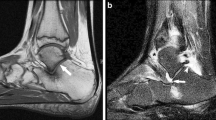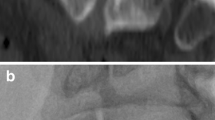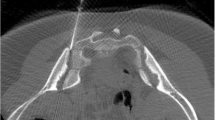Abstract
Background
Children with arthritis may endure a lifetime of disfigurement, dysfunction, and pain if acute inflammation progresses to chronic changes in the joint cartilage and underlying bone. Intraarticular steroids have become an integral component of treatment, but at times are difficult to deliver to joints, such as the subtalar joint, that have complex anatomies.
Objective
We describe our technique and outcomes using fluoroscopically guided intraarticular subtalar steroid injection in patients with active symptoms of juvenile idiopathic arthritis (JIA).
Materials and methods
Fluoroscopically guided subtalar joint injections were performed in 38 children (mean age 6.7 years). Medical records were reviewed retrospectively and improvement was evaluated clinically by the degree of foot movement in eversion and inversion.
Results
Subtalar joint injection was technically successful in 100% of the JIA patients with improvement in physical symptoms in 34/38 (89%). Of the 38 children, 32 were followed up within 13 weeks of the initial injection and, therefore, satisfied the eligibility criteria for resolution of arthritis. Of these 32 children, 14 showed clinical resolution (44%). The mean duration of improvement was 1.2 ± 0.9 years. Children with a longer interval (>1 year) from diagnosis to treatment had significantly less resolution (P = 0.04). Local subcutaneous atrophy or hypopigmentation were observed in 53% of the children after steroid injection (20/38). These minor complications were associated with a greater volume of steroid injected into the site per child (P = 0.02).
Conclusion
Fluoroscopically guided subtalar joint injection is an effective treatment for subtalar arthropathy. Prompt referral for intraarticular steroid treatment in the acute phase improves response. Skin changes often occur at the injection site, and specific precautions should be employed to reduce this risk. Prospective study is indicated to determine the most effective treatment strategy to prevent long-term pain and disability.

Similar content being viewed by others
References
Belt EA, Kaarela K, Maenpaa H et al (2001) Relationship of ankle joint involvement with subtalar destruction in patients with rheumatoid arthritis. A 20-year follow-up study. Joint Bone Spine 68:154–157
Sammarco GJ, Tablante EB (1998) Subtalar arthrodesis. Clin Orthop Relat Res 349:73–80
Wu WL, Huang PJ, Lin CJ et al (2005) Lower extremity kinematics and kinetics during level walking and stair climbing in subjects with triple arthrodesis or subtalar fusion. Gait Posture 21:263–270
Hashkes PJ, Laxer RM (2005) Medical treatment of juvenile idiopathic arthritis. JAMA 294:1671–1684
Sherry DD, Stein LD, Reed AM et al (1999) Prevention of leg length discrepancy in young children with pauciarticular juvenile rheumatoid arthritis by treatment with intraarticular steroids. Arthritis Rheum 42:2330–2334
Arabshahi B, Dewitt EM, Cahill AM et al (2005) Utility of corticosteroid injection for temporomandibular arthritis in children with juvenile idiopathic arthritis. Arthritis Rheum 52:3563–3569
Remedios D, Martin K, Kaplan G et al (1997) Juvenile chronic arthritis: diagnosis and management of tibio-talar and sub-talar disease. Br J Rheumatol 36:1214–1217
Beukelman T, Arabshahi B, Cahill AM et al (2006) Benefit of intraarticular corticosteroid injection under fluoroscopic guidance for subtalar arthritis in juvenile idiopathic arthritis. J Rheumatol 33:2330–2336
Pugh MT, Grosse R, Southwood TR (1995) Intra-articular corticosteroids in JCA: a 12-month prospective study of simultaneous multiple joint injections (abstract). Clin Exp Rheumatol 13:559
Gray RG, Tenenbaum J, Gottlieb NL (1981) Local corticosteroid injection treatment in rheumatic disorders. Semin Arthritis Rheum 10:231–254
Job-Deslandre C, Menkes CJ (1990) Complications of intra-articular injections of triamcinolone hexacetonide in chronic arthritis in children. Clin Exp Rheumatol 8:413–416
Breit W, Frosch M, Meyer U et al (2000) A subgroup-specific evaluation of the efficacy of intraarticular triamcinolone hexacetonide in juvenile chronic arthritis. J Rheumatol 27:2696–2702
Padeh S, Passwell JH (1998) Intraarticular corticosteroid injection in the management of children with chronic arthritis. Arthritis Rheum 41:1210–1214
Chakravarty K, Pharoah PD, Scott DG (1994) A randomized controlled study of post-injection rest following intra-articular steroid therapy for knee synovitis. Br J Rheumatol 33:464–468
Zulian F, Martini G, Gobber D et al (2003) Comparison of intra-articular triamcinolone hexacetonide and triamcinolone acetonide in oligoarticular juvenile idiopathic arthritis. Rheumatology (Oxford) 42:1254–1259
Zulian F, Martini G, Gobber D et al (2004) Triamcinolone acetonide and hexacetonide intra-articular treatment of symmetrical joints in juvenile idiopathic arthritis: a double-blind trial. Rheumatology (Oxford) 43:1288–1291
Balint PV, Kane D, Sturrock RD (2001) Modern patient management in rheumatology: interventional musculoskeletal ultrasonography. Osteoarthritis Cartilage 9:509–511
Tynjala P, Honkanen V, Lahdenne P (2004) Intra-articular steroids in radiologically confirmed tarsal and hip synovitis of juvenile idiopathic arthritis. Clin Exp Rheumatol 22:643–648
Kane D, Balint PV, Sturrock R et al (2004) Musculoskeletal ultrasound – a state of the art review in rheumatology. Part 1: Current controversies and issues in the development of musculoskeletal ultrasound in rheumatology. Rheumatology (Oxford) 43:823–828
Kane D, Grassi W, Sturrock R et al (2004) Musculoskeletal ultrasound – a state of the art review in rheumatology. Part 2: Clinical indications for musculoskeletal ultrasound in rheumatology. Rheumatology (Oxford) 43:829–838
Acknowledgements
This study was supported in part by grants to R.Q.C. from the Nickolett Family Awards Program for JRA Research and the Ethel Brown Foerderer Fund for Excellence.
Author information
Authors and Affiliations
Corresponding author
Rights and permissions
About this article
Cite this article
Cahill, A.M., Cho, S.S., Baskin, K.M. et al. Benefit of fluoroscopically guided intraarticular, long-acting corticosteroid injection for subtalar arthritis in juvenile idiopathic arthritis. Pediatr Radiol 37, 544–548 (2007). https://doi.org/10.1007/s00247-007-0457-6
Received:
Revised:
Accepted:
Published:
Issue Date:
DOI: https://doi.org/10.1007/s00247-007-0457-6




